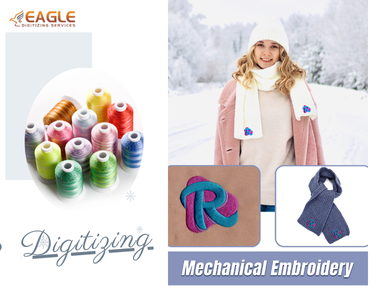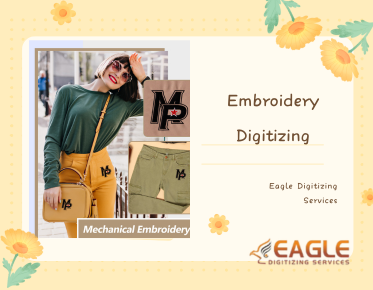Essential Guide to Selecting Suitable Embroidery Fabrics and Threads from Eagle Digitizing
Embroidery is more than just needle and thread. The choice of fabric and thread is fundamental to the success of your project. The right combination can elevate your design, while the wrong pairing can undermine hours of meticulous work. Understanding the interplay between fabric and thread ensures your designs are vibrant, durable, and beautiful. Read Here are Some Things That You Should Know When It Comes To Embroidery Digitizing!
The Perfect Match: Aligning Fabric, Thread, and Design
Finding the perfect match between fabric, thread, and design is an art in itself. Each element must complement the others to bring out the best in your embroidery. Whether it's a bold, colorful creation or a delicate, intricate pattern, aligning these components is key to achieving your desired aesthetic and functionality.
Understanding Embroidery Fabrics
Different Types of Embroidery Fabrics Explained
Embroidery fabrics come in a variety of types, each with unique properties that can affect the outcome of your project. Understanding these differences helps in selecting the best fabric for your design.
Cotton: The Classic Choice for Embroidery
Cotton is a staple in the embroidery industry. It’s easy to work with, durable, and readily available. Its versatility makes it suitable for a wide range of embroidery techniques, from cross-stitch to freeform designs.
Linen: Elegant and Durable
Linen brings a touch of elegance to embroidery projects. Its natural fibers provide a beautiful texture, and it’s strong enough to withstand detailed stitching. Linen’s durability makes it a favorite for heirloom pieces.
Silk: Luxurious and Delicate
Silk is the epitome of luxury in embroidery fabrics. Its smooth, lustrous surface is perfect for delicate, intricate designs. However, its delicate nature requires careful handling and expert technique.
Aida Cloth: Ideal for Cross-Stitch
Aida cloth is specifically designed for cross-stitching. Its distinct grid pattern makes it easy to follow complex designs, ensuring even, precise stitches. It’s a favorite among beginners and experts alike.
Evenweave: Balanced and Versatile
Evenweave fabric offers a balanced grid that’s perfect for a variety of embroidery techniques. Its uniform weave allows for consistent stitching, making it a versatile choice for both counted and freeform embroidery.
Factors to Consider When Choosing Fabric
Fabric Weight: How It Affects Your Design
Fabric weight plays a crucial role in embroidery. Lighter fabrics are great for delicate, airy designs, while heavier fabrics can support more intricate, dense stitching. Choosing the right weight ensures your fabric complements your design.
Fabric Weave: Open vs. Tight Weaves
The weave of the fabric affects the ease of stitching and the overall appearance of your embroidery. Open weaves are easier to stitch through but may not support very detailed work. Tight weaves provide a sturdy base for intricate designs but can be more challenging to stitch.
Color Considerations: Choosing the Right Hue
The color of your fabric can enhance or detract from your embroidery. Consider how the fabric color will interact with your thread colors. Light fabrics are versatile and forgiving, while dark fabrics can make vibrant threads pop but may require more precision.
Fabric Stretch: Pros and Cons for Embroidery
Fabric stretch can influence the final look of your embroidery. Stretchy fabrics may distort your design, while stable fabrics maintain the integrity of your stitches. Understanding the pros and cons helps in selecting the best fabric for your project.
Exploring Embroidery Threads
Types of Embroidery Threads: An Overview
Embroidery threads come in various types, each offering unique qualities. Knowing these types helps in choosing the right thread for your design.
Cotton Threads: Soft and Versatile
Cotton threads are soft and versatile, making them suitable for a wide range of projects. They’re available in a variety of weights and colors, providing flexibility and ease of use.
Silk Threads: Shiny and Strong
Silk threads add a touch of luxury to embroidery. Their natural sheen and strength make them ideal for intricate, delicate designs that require a polished finish.
Metallic Threads: Adding a Touch of Sparkle
Metallic threads bring sparkle and shine to your embroidery. They’re perfect for accents and highlights but require careful handling to prevent fraying and breakage.
Rayon Threads: Vibrant and Glossy
Rayon threads are known for their vibrant colors and glossy finish. They’re a great choice for projects that need a burst of color and shine.
Wool Threads: Textured and Warm
Wool threads offer a textured, warm finish that’s perfect for adding depth and dimension to your embroidery. They’re especially popular in crewel embroidery for their rich, tactile quality.
Thread Characteristics to Keep in Mind
Thread Weight and Thickness: Impact on Your Design
Thread weight and thickness affect the texture and coverage of your embroidery. Thicker threads provide bold, prominent stitches, while finer threads offer delicate, detailed work.
Thread Finish: Matte, Glossy, or Metallic?
The finish of your thread can change the look of your embroidery. Matte threads offer a subtle, understated appearance, glossy threads provide a polished look, and metallic threads add sparkle and shine.
Colorfastness: Ensuring Your Colors Last
Colorfastness is crucial for ensuring your embroidery retains its vibrancy over time. Choose threads that are resistant to fading and bleeding, especially for items that will be washed or exposed to light.
Matching Fabric and Thread to Your Design
Bold Designs: Choosing the Right Pairings
Bold designs benefit from strong, vibrant threads and sturdy fabrics. Choose combinations that make your design stand out while maintaining the integrity of the fabric and thread.
Delicate Patterns: Fabrics and Threads That Shine
Delicate patterns require a careful selection of fabric and thread to enhance their intricate details. Lightweight fabrics and fine, smooth threads work best to highlight the elegance of delicate designs.
Monochrome Embroidery: Creating Depth with Textures
Monochrome embroidery relies on texture to create depth and interest. Use a variety of stitches and thread weights to add dimension, and choose fabrics that complement the single-color palette.
Colorful Creations: Balancing Fabric and Thread Choices
For colorful creations, balance is key. Ensure your fabric color enhances your thread choices, and consider how different thread finishes will interact with the fabric to create a harmonious, vibrant design.
Techniques and Their Fabric/Thread Needs
Cross-Stitch: Best Fabrics and Threads
Cross-stitch benefits from fabrics like Aida cloth and even weave, which provide a clear grid for accurate stitching. Cotton threads are a popular choice for their versatility and ease of use.
Crewel Embroidery: Traditional Materials
Crewel embroidery traditionally uses linen or heavy cotton fabric and wool threads. These materials complement the textured, detailed nature of crewel work, providing a rich, tactile finish.
Needlepoint: Ideal Fabric and Thread Combinations
Needlepoint requires sturdy fabrics like canvas or interlock, paired with wool or cotton threads. These combinations ensure the durability and clarity of the intricate needlepoint designs.
Satin Stitch: Choosing Smooth Threads and Fabrics
Satin stitch demands smooth threads like silk or rayon for a polished, glossy finish. Choose fabrics with a tight weave to support the even, dense stitches of the satin technique.
Blackwork: High Contrast Fabric and Thread Pairings
Blackwork relies on high contrast between fabric and thread. Opt for stark white or cream fabrics paired with black or dark-colored threads to highlight the intricate patterns and details.
Advanced Techniques and Materials
Goldwork: Using Metal Threads and Special Fabrics
Goldwork embroidery uses metal threads to create luxurious, shimmering designs. Choose special fabrics like silk or velvet that can support the weight and complexity of metal threads.
Bead Embroidery: Supporting Fabrics and Strong Threads
Bead embroidery requires sturdy fabrics that can support the weight of the beads. Use strong threads like nylon or polyester to ensure the beads are securely attached and the fabric doesn’t tear.
Ribbon Embroidery: Selecting Ribbons and Compatible Fabrics
Ribbon embroidery involves using ribbons instead of threads, creating a unique, textured effect. Choose fabrics that can support the width and weight of the ribbons, and select ribbons that complement your fabric choice.
Practical Tips for Selection
Testing Fabric and Thread Combinations
Before committing to a project, test your fabric and thread combinations. This helps you see how the materials work together and allows for adjustments before starting the main piece.
Mixing and Matching for Unique Effects
Don’t be afraid to mix and match different fabrics and threads to create unique effects. Combining various textures and finishes can add depth and interest to your embroidery.
Shopping Tips: Where to Find Quality Materials
Quality materials are essential for successful embroidery. Shop at reputable stores, both online and offline, that specialize in embroidery supplies. Look for reviews and recommendations to ensure you’re getting the best products.
Common Challenges and Solutions
Dealing with Fabric Puckering
Fabric puckering is a common issue in embroidery. To prevent it, use the appropriate stabilizer and ensure your fabric is properly hooped and tensioned. Adjusting your stitch density can also help reduce puckering.
Preventing Thread Breakage
Thread breakage can be frustrating. Use high-quality threads and needles, and ensure your tension settings are correct. Avoid overly long thread lengths and handle metallic and specialty threads with care.
Color Bleeding: How to Avoid It
Color bleeding can ruin your embroidery. Choose colorfast threads and pre-wash your fabric to remove any excess dyes. Test a small section before starting your project to ensure the colors won’t bleed.
Caring for Embroidered Pieces
Washing and Cleaning Tips
Proper care extends the life of your embroidered pieces. Hand wash with mild detergent and avoid harsh chemicals. Rinse thoroughly and lay flat to dry, keeping out of direct sunlight to prevent fading.
Storing Your Embroidered Fabrics Safely
Store your embroidered fabrics in a cool, dry place away from direct sunlight. Use acid-free tissue paper to wrap your pieces and avoid folding them to prevent creases. Proper storage maintains their beauty and integrity.
Showcasing Your Work
Displaying Finished Embroidery Art
Display your finished embroidery art to show off your hard work. Frame your pieces with UV-protective glass to prevent fading, and choose a frame that complements the design. Hang your artwork in a prominent place for all to admire.
Gift Ideas: Creating Personal Keepsakes
Embroidery makes a thoughtful, personalized gift. Consider creating custom pieces for friends and family, such as monogrammed towels, embroidered portraits, or decorative wall hangings. These personal keepsakes are cherished and unique. For the best digitizing service, please feel free to contact us.
Mastering the art of selecting suitable embroidery fabrics and threads is a journey of experimentation and learning. The perfect pairing brings your designs to life, showcasing the harmony between fabric and thread.
Don’t be afraid to experiment and explore new combinations. The world of embroidery is vast and full of possibilities. Embrace the creative process and enjoy the journey of discovering your perfect fabric and thread pairings.



